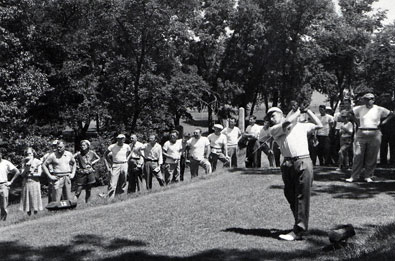Inside Iowa State
Inside ArchivesSubmit newsSend news for Inside to inside@iastate.edu, or call (515) 294-7065. See publication dates, deadlines. About InsideInside Iowa State, a newspaper for faculty and staff, is published by the Office of University Relations. |
June 28, 2007 
Iowa State's golf course played host to the 1949 NCAA Championship. Arnold Palmer, then the top player from Wake Forest University, was a medalist at the event. Here, an NCAA qualifier tees off at No. 12 with a gallery of onlookers. A sesquicentennial look backVeenker's legacyby Erin Rosacker With the help of a $500 gift from alumni Bill Lane ('09) and Walter Wells ('10), the Alumni Fund trustees purchased 152 acres of cow pasture and orchard just north of campus, adjacent to the intramural fields. It was athletics director George Veenker's vision that became a reality on the site -- a multipurpose recreation area that boasted an 18-hole golf course, 3.5 miles of cinder hiking and bridle trails, a cross country course, picnic areas and shelter houses. Veenker brought in Perry Maxwell and Philip Elwood to help design the recreational area's layout. Maxwell, considered one of the best golf course designers in history, also created the original nine holes at Prairie Dunes (Kansas) and retooled a pair of greens at Augusta National (Georgia). Elwood was head of Iowa State's landscape architecture program. Work started in 1935, utilizing manpower and funding from the Works Progress Administration, Civilian Conservation Corps and many of the college's departments. Mountains of earth were moved, an estimated 4,000 trees were cut down and 5,000 more were planted strategically throughout the area. Walnut logs from cleared timber were used to create tee markers, benches and a clubhouse. Fittingly, the end result was dedicated during the 1938 Veishea celebration. On the original par-70 course, the No. 1 and No. 18 holes were situated south of the railroad tracks. Today, that area serves as an outdoor classroom for golf classes, ROTC maneuvers and engineering instruction. The original No. 18 green and practice green are on the south end (near Bissell Road) and the old No. 1 green is on the north. An undulating, tree-lined fairway stretches approximately 300 yards between them. The Iowa State University Golf Course was re-named the George F. Veenker Memorial Golf Course in 1959, less than two months after Veenker's death. In 1971, the city of Ames began work to expand 13th Street to meet Ontario Road, cutting a swath through the south end of the original course. In 1973, Veenker opened its doors again as a re-numbered course with three new holes (replacing the ones lost or isolated by road construction), a new clubhouse, practice tee, driving range and expanded parking. Hole modifications in 1988 helped keep errant golf balls from hitting cars traveling along 13th Street, and a shuffle in hole order made play more efficient. Most holes retained their unique names from the original course. For example, "Davey Jones" remains a tough par 3 that requires players to hit across Squaw Creek. It was the site of the course's first hole-in-one, made by Cyclone team member Bob Schrieber during the first round played on the course just a day before the 1938 dedication. With tweaks and changes over the years, the course retained its challenging reputation, playing host to the 1949 NCAA Championship, a pair of women's collegiate regional tournaments and two Big Eight Conference women's championships. It is the yearly site of the prestigious Iowa Masters tournament, and earned national recognition from both Golf Digest and Golfweek magazines. Today, Veenker Memorial Golf Course is a par-72 facility (par 73 for women). The Cyclone men's and women's golf teams still call it home and now enjoy the recent addition of partially enclosed heated hitting bays that allow them to use the driving range year round. This fall, the athletics department will induct George Veenker into its hall of fame. |
Summary

Sesqui seriesInside is running a yearlong series of photos and articles that look back at Iowa State traditions, people and places to celebrate the sesquicentennial. |